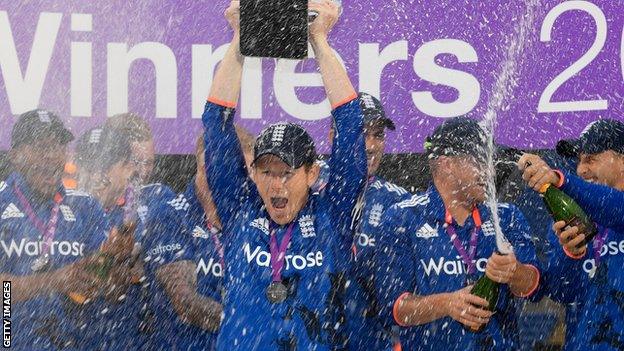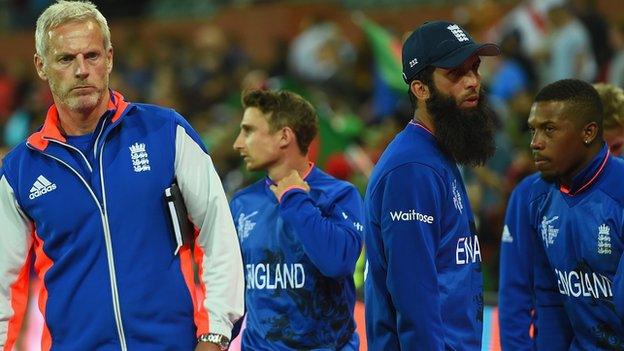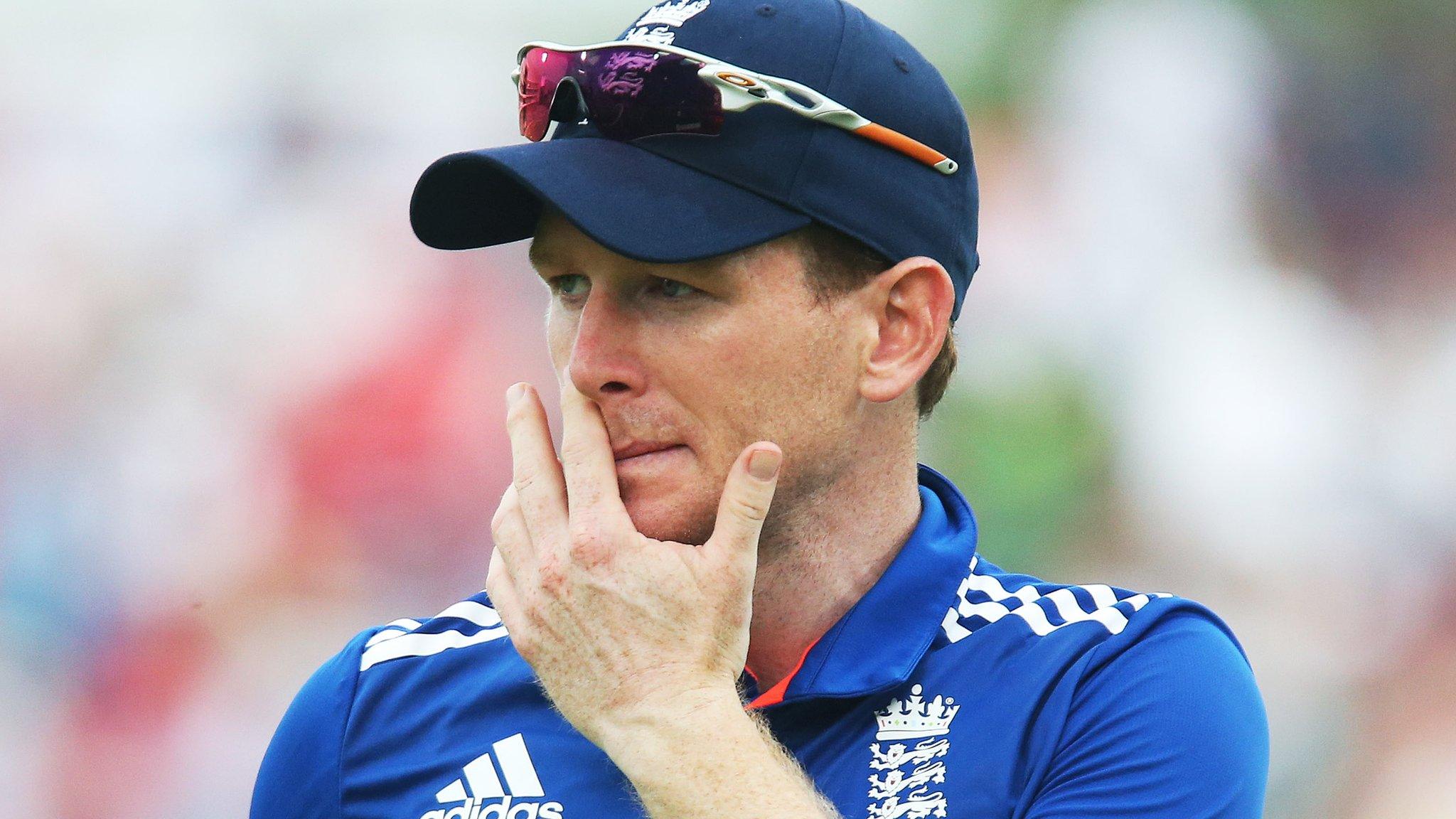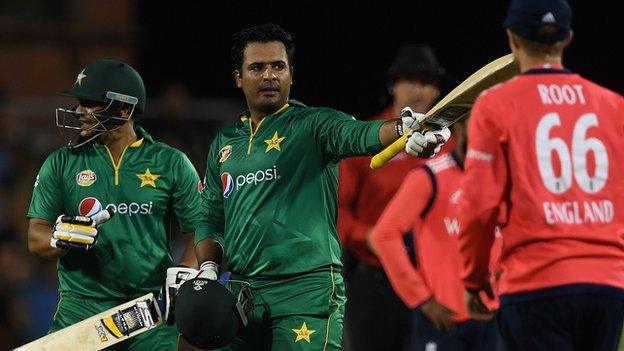How England's one-day fortunes have been transformed since 2015 World Cup
- Published
- comments

England have won four of their six one-day series since the 2015 World Cup
There is an English way of doing things.
See a queue, get in it. Apologise even though you were the one bumped in to. Cheer when a glass is smashed in the pub.
The English way of playing one-day cricket - nice and steady at the start, wickets in hand, have a bash at the end - last had major success 24 years ago with a run to the 1992 World Cup final.
If that was a time when the tortoise managed to keep pace with the hare, then the following 23 years saw the rest of the world accelerate past England. Those nations did so to such a degree that at times it looked as if they were playing a different sport.
Former off-spinner Graeme Swann tells a tale of how England were told that if they scored 239, they would win 72% of games.
"In the 2011 World Cup quarter-final against Sri Lanka in Colombo, we had batted to our plan almost perfectly and scored 229. Jonathan Trott got 86 in 115 balls," said Swann.
"Everyone said 'brilliant'. Then Sri Lanka knocked them off in 39.3 overs."
The nadir came at the 2015 World Cup, an embarrassing exit sealed with defeat by Bangladesh, a result described as "pathetic" by legendary England all-rounder Sir Ian Botham.
It was thought by many than an inflexible approach and an over-reliance on statistics, external hampered Eoin Morgan's men in Australia and New Zealand.

England's defeat by Bangladesh sealed their exit from the 2015 World Cup
Now, instead of looking at data, England see the ball and whack it out of the ground. There is a new English way, one that was born in their first completed ODI after the World Cup.
On that sunny afternoon at Edgbaston, with current assistant coach Paul Farbrace keeping the hotseat warm for Trevor Bayliss, England plundered their first ODI score in excess of 400 against a New Zealand side who had previously provided them with a blueprint on how to play the 50-over game.
"A lot has can be said for former New Zealand captain Brendon McCullum, who is best mates with Eoin Morgan," said Swann.
"He tore up the book in and said to his team: 'Whatever has happened in the past in nonsense. It's a new game, play with freedom and your team-mates back you.' England are now playing with a similar amount of freedom.
"Morgan has taken that to the England team, Trevor Bayliss has allowed that to happen and director of cricket Andrew Strauss has separated the one-day team from the Test team. It was a blatant move that had to be made - it just took some chutzpah to do it."
Since the 2015 World Cup, England's win ratio in ODIs of 1.75 - which is 1.75 wins for every defeat - is bettered only by world champions Australia's 2.13.
Former captain Michael Vaughan has called this team the best England one-day side he has seen, while BBC Test Match Special's Simon Hughes, the ex-Middlesex seamer, wrote in the Times that the current crop must grab their opportunity to win a global trophy in the next decade.
England one-day series results since 2015 World Cup | ||
|---|---|---|
Opponent | Result | Scoreline |
New Zealand (h) | Won | 3-2 |
Australia (h) | Lost | 2-3 |
Pakistan (n) | Won | 3-1 |
South Africa (h) | Lost | 2-3 |
Sri Lanka (h) | Won | 3-0 |
Pakistan (h) | Won | 4-1 |
England's transformation built on batting
In the main, England's spectacular upturn has been built on a batting line-up that is as destructive, dynamic and boundary-hungry as any other on the planet.
Prior to the World Cup, England were chugging along at only 5.18 runs per over, slower than every other Test side apart from Zimbabwe and Bangladesh.
Since then, players such as Jason Roy, Alex Hales, Joe Root and Jos Buttler have bumped England along at 6.33 runs an over, a scoring rate faster than any other nation.
In the same period, six men have scored more than 500 ODIs runs at a strike-rate of better than a run a ball. Half of them are English - Buttler, Roy and Ben Stokes.
During the past 15 months, England have posted six of their eight highest totals of all time.
Twice they have passed 400, including the world-record 444-3 in the third ODI against Pakistan at Trent Bridge last month, in which Hales' 171 broke a 23-year record for the highest score by an England batsman.
Of England's first-choice top seven, Hales is one of five survivors from the World Cup, which shows it is a change of approach, rather than a change of personnel, that has sparked such a shift.
These men have not learned new shots, do not hit the ball any further than they did before, but simply have the freedom and confidence to play to the limit of their ability.
Better bowling - but with room to improve
If the batting line-up has seen few changes, then the bowling attack has been overhauled.
Whereas the World Cup saw England dine exclusively on a diet of right-arm fast-medium and off-spin, new England agree with the rest of the world that variety is the spice of life.
In have come left-armer David Willey, the extra pace of Liam Plunkett and Mark Wood, along with the mystery of Adil Rashid's leg-spin.
Since the World Cup, Willey and fellow left-armer Reece Topley have the best strike-rate of all England bowlers to have taken at least 10 ODI wickets, while Rashid's 38 wickets is higher than any other bowler on the planet.
Still, it is bowling that provides England with room for improvement.
While England are not alone in conceding more runs per over since the World Cup than the year before (5.73 now compared to 5.43), their economy is still only better than four other major nations.
Before the tournament down under, England were more miserly than only Pakistan, New Zealand and Sri Lanka. That remains the case.
If that involves looking at the attack as whole, then individual numbers can also be bettered.
In the past year and a half, 27 bowlers worldwide have taken 10 wickets or more and conceded fewer than five runs per over. None is English.
Fielding is also an area where England can find further gains. Of the current squad, only Roy, Stokes, Jonny Bairstow and Chris Jordan could be considered of the highest class and the latter two are not in the current strongest XI.
Learn the lessons, slay the demons
Even with these gains still to be made, England are currently one of the finest one-day sides in the world and would be among the favourites if a global tournament began tomorrow.
As it is, they must wait for the Champions Trophy on home soil next summer, or the World Cup, again in the UK, in 2019.
And therein lies a note of caution, for England have previously shown form between World Cups, only to be humbled on the biggest stage.
Just over a year after the 2011 World Cup, England found themselves top of the world rankings after a 4-0 home series win over Australia.
That counted for little when Michael Clarke's men were crowned world champions in the spring of 2015.
"Us getting to number one was an anomaly," said Swann. "We played a lot of games at home, in English conditions and it nearly always rained before the game - our seamers had a field day.
"We were playing decent cricket, but not the new brand where anything is possible.
"We had a good team, but everyone else quickly realised that to move forward you have to throw away all the old rules."
However, there is no reason to believe that England cannot continue on their upward curve, especially with all bar one of the current squad - Plunkett - below the age of 30.
If they do, there is the opportunity, in front of their home fans, to lay to rest some significant demons that lurk in the past of English cricket.
The first involves the Champions Trophy, where England have twice hosted the tournament and twice lost finals in agonising circumstances - to West Indies in 2004 and India in 2013.
Then comes the World Cup. In 1999, England were humiliated on home soil and in 2015 they were just humiliated.
Maybe, just maybe, at Lord's in the summer of 2019, an England captain may finally get his hands on the biggest prize in one-day cricket and end a 44-year wait.
- Published7 September 2016

- Published7 September 2016

- Published7 September 2016

- Published10 March 2019

- Published15 May 2018

- Published18 October 2019
